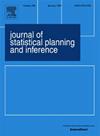Consistent community detection approach in the nonparametric weighted stochastic blockmodel with unspecified number of communities
IF 0.8
4区 数学
Q3 STATISTICS & PROBABILITY
引用次数: 0
Abstract
The stochastic blockmodel (SBM) is a widely used model for representing graphs. Numerous approaches have been applied to the SBM to detect latent community structures in graphs, typically using two types of consistency (strong and weak) to evaluate their performance. Most of these methods have been studied and shown to be consistent under the SBM framework. However, the consistency of the weighted SBM, an important extension of the SBM, has been largely overlooked. Moreover, few approaches are capable of detecting communities when the number of communities is unknown. In this paper, we propose a nonparametric method for effective community detection under the assortative, nonparametric weighted SBM with an unknown number of communities, and we establish the consistency of our approach. We introduce a novel concept, “consistency in relationship”, as a more practical criterion to assess the performance of community detection algorithms. Since solving the optimization problem in our approach becomes intractable for large sample sizes, we propose an efficient algorithm to approximate it. Simulations demonstrate that our community detection method is both efficient and robust, particularly for unbalanced networks. We illustrate the effectiveness of our approach on three real-world networks.
非参数加权随机块模型中未指定社团数的一致性社团检测方法
随机块模型(SBM)是一种广泛使用的图表示模型。许多方法已经应用于SBM来检测图中的潜在群落结构,通常使用两种类型的一致性(强和弱)来评估它们的性能。这些方法大多已被研究,并显示在SBM框架下是一致的。然而,加权SBM的一致性是SBM的重要延伸,在很大程度上被忽视了。此外,很少有方法能够在社区数量未知的情况下检测社区。本文提出了一种非参数方法,用于在未知社团数量的分类、非参数加权SBM下进行有效的社团检测,并验证了该方法的一致性。我们引入了一个新的概念,“关系一致性”,作为评估社区检测算法性能的一个更实用的标准。由于在我们的方法中求解优化问题对于大样本量变得难以处理,我们提出了一个有效的算法来近似它。仿真结果表明,该方法具有较好的鲁棒性和有效性,尤其适用于不平衡网络。我们在三个现实世界的网络上说明了我们的方法的有效性。
本文章由计算机程序翻译,如有差异,请以英文原文为准。
求助全文
约1分钟内获得全文
求助全文
来源期刊
CiteScore
2.10
自引率
11.10%
发文量
78
审稿时长
3-6 weeks
期刊介绍:
The Journal of Statistical Planning and Inference offers itself as a multifaceted and all-inclusive bridge between classical aspects of statistics and probability, and the emerging interdisciplinary aspects that have a potential of revolutionizing the subject. While we maintain our traditional strength in statistical inference, design, classical probability, and large sample methods, we also have a far more inclusive and broadened scope to keep up with the new problems that confront us as statisticians, mathematicians, and scientists.
We publish high quality articles in all branches of statistics, probability, discrete mathematics, machine learning, and bioinformatics. We also especially welcome well written and up to date review articles on fundamental themes of statistics, probability, machine learning, and general biostatistics. Thoughtful letters to the editors, interesting problems in need of a solution, and short notes carrying an element of elegance or beauty are equally welcome.

 求助内容:
求助内容: 应助结果提醒方式:
应助结果提醒方式:


